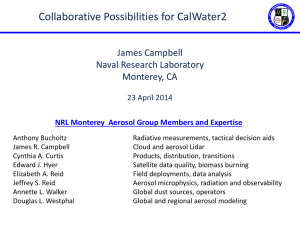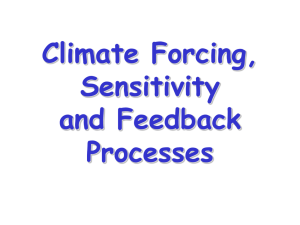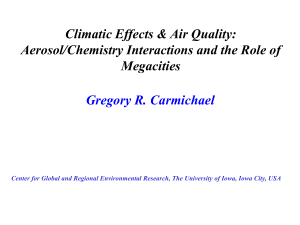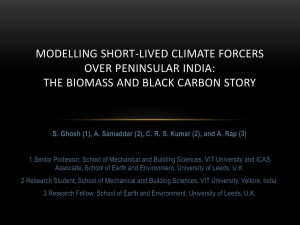Aerosol optical properties and radiative forcing during UAE2
advertisement
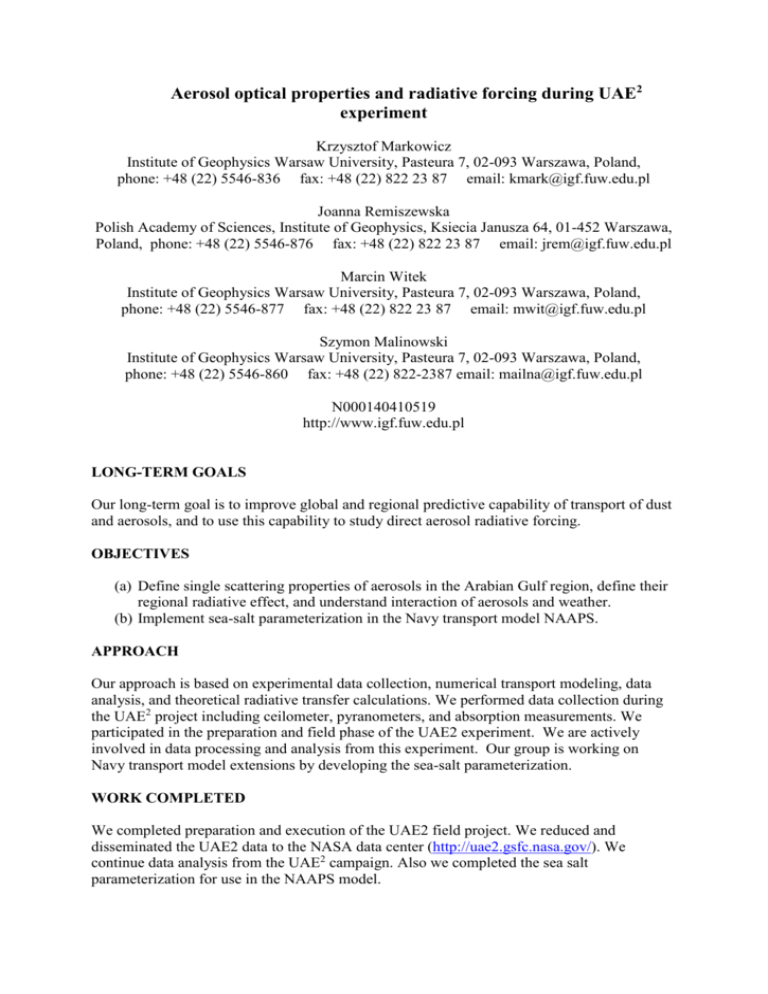
Aerosol optical properties and radiative forcing during UAE2 experiment Krzysztof Markowicz Institute of Geophysics Warsaw University, Pasteura 7, 02-093 Warszawa, Poland, phone: +48 (22) 5546-836 fax: +48 (22) 822 23 87 email: kmark@igf.fuw.edu.pl Joanna Remiszewska Polish Academy of Sciences, Institute of Geophysics, Ksiecia Janusza 64, 01-452 Warszawa, Poland, phone: +48 (22) 5546-876 fax: +48 (22) 822 23 87 email: jrem@igf.fuw.edu.pl Marcin Witek Institute of Geophysics Warsaw University, Pasteura 7, 02-093 Warszawa, Poland, phone: +48 (22) 5546-877 fax: +48 (22) 822 23 87 email: mwit@igf.fuw.edu.pl Szymon Malinowski Institute of Geophysics Warsaw University, Pasteura 7, 02-093 Warszawa, Poland, phone: +48 (22) 5546-860 fax: +48 (22) 822-2387 email: mailna@igf.fuw.edu.pl N000140410519 http://www.igf.fuw.edu.pl LONG-TERM GOALS Our long-term goal is to improve global and regional predictive capability of transport of dust and aerosols, and to use this capability to study direct aerosol radiative forcing. OBJECTIVES (a) Define single scattering properties of aerosols in the Arabian Gulf region, define their regional radiative effect, and understand interaction of aerosols and weather. (b) Implement sea-salt parameterization in the Navy transport model NAAPS. APPROACH Our approach is based on experimental data collection, numerical transport modeling, data analysis, and theoretical radiative transfer calculations. We performed data collection during the UAE2 project including ceilometer, pyranometers, and absorption measurements. We participated in the preparation and field phase of the UAE2 experiment. We are actively involved in data processing and analysis from this experiment. Our group is working on Navy transport model extensions by developing the sea-salt parameterization. WORK COMPLETED We completed preparation and execution of the UAE2 field project. We reduced and disseminated the UAE2 data to the NASA data center (http://uae2.gsfc.nasa.gov/). We continue data analysis from the UAE2 campaign. Also we completed the sea salt parameterization for use in the NAAPS model. PERSONNEL EXCHANGES AND TRAVEL COMPLETED Table 1. Summary of personnel exchanges and travel conducted under this NICOP. Name Home Institution / Scientific / Technical Dates Institution Location Visited Purpose of visit (mm/dd/yy) Marcin Institute of NRL NAAPS model 11/25/04Witek Geophysics UW improvements 02/20/05 Krzysztof Institute of Department of Field project UAE2 08/01/04Markowicz Geophysics UW Water Resources 09/11/04 Studies, UAE Marcin Institute of Department of Field project UAE2 08/01/04Witek Geophysics UW Water Resources 09/01/04 Studies, UAE Joanna Polish Academy Department of Field project UAE2 09/01/04Remiszewska of Science Water Resources 09/11/04 Studies, UAE RESULTS 1.1 Experiment overview The Unified Aerosol Experiment-United Arab Emirates (UAE2) took place in AugustSeptember 2004. It covered coastal and desert regions of the United Arab Emirates. Main goals of UAE2 campaign were: (1) determine the fundamental microphysical, optical and transport properties of aerosol particles in this mostly un-sampled region; (2) understand how aerosol particles interact with the regional radiation budget. During the UAE2 campaign 16 Aerosol Robotic Network (AERONET) Sun Photometer stations were established in United Arab Emirates to monitor aerosol optical properties. The NRL Mobile Atmospheric Aerosol and Radiation Characterization Observatory (MAARCO) and GSFC Surface-sensing Measurements for Atmospheric Radiative Transfer (SMART) research containers were deployed on the coast and desert regions of the UAE to provide information on surface radiation and aerosol properties. These surface measurements were complemented by research aircraft. 1.2 MAARCO Instrumentation: The Mobile Atmospheric Aerosol and Radiation Characterization Observatory (MAARCO) is a shipping container that has been modified to function as an easily-shipped laboratory Its purpose it to perform basic research on atmospheric aerosols, gases, and radiation (in visible and IR bands). The MAARCO container was located in the north-eastern part of the UAE at 54.659 E, 24.700 N about 5 meters above the sea level. This site is strongly influenced by ship traffic in the Arabian Gulf and refineries and other antropogenic activities. As an integrated laboratory, MAARCO contains a suite of aerosol particle and gas instruments including the following: 1 Instrument Aeronet Sun Photometers: 2 2 3 4 5 Pyranometers, 2 Pyrgeometers, 2 Pyrheliometer Solar tracker Measured and retrieved parameters Aerosol optical thickness, single scattering albedo, asymmetry parameter Total and diffuse solar radiation Total and diffuse infrared radiation Direct solar radiation 6 7 Total Sky Imager Nephelometer 8 Aethalometer 9 10 11 12 Ceilometer CT25K Aerodynamic Particle Sizer TSP filter Pump Tapered Element Oscillating Mass Balance Optical Particle Counters SO2 Monitor Ozone monitor MOUDI sampler MPL LIDAR Weather Station 13 14 15 16 17 18 19 Mini-Rawinsonde System (MRS) AN/UMQ-12 Clouds cover Aerosol scattering and backscattering coefficients Black carbon concentration and aerosol absorption coefficient Two-way attenuation coefficient Aerodynamic diameter Mass and elemental composition Aerosol mass Particle concentration Surface SO2 concentration Surface ozone concentration Aerosol size distribution Vertical profiles of extinction coefficient Temperature, relative humidity, wind speed and direction. Vertical profiles of pressure, temperature, relative humidity 1.3 Column integrated and surface aerosol optical properties. Observations of direct and diffuse spectral solar radiation provided information about the aerosol optical thickness (AOT), scattering phase function and single scattering albedo (SSA). In contrast to the AOT, retrieval of the scattering phase function and the SSA is more Fig.1 Temporal variability of the aerosol optical thickness at 500 nm, Angstrom exponent and the single scattering albedo at 441 nm. complicated and is sensitive to the model of choice. In this study we used the AERONET combined spherical and spheroid particles model retrievals because of significant amount of nonspherical mineral dust particles in the atmosphere. Fig. 1 shows a temporal variability of aerosol optical properties during the UAE2 campaign. The mean AOT observed at MAARCO station is about 0.5 at 500 nm. This large value is due to mineral dust and anthropogenic aerosol. Values of the Angstrom exponents below 0.7-0.6 are correlated with the strong dust events. We observed two cases of mineral dust storms during the measuring period. The first case was associated with the long range transport from Afghanistan and Iran. The second one was related to local dust production. The large scale transport controlled columnar integrated aerosol properties while local dust storm affected mostly surface aerosol properties. The SSA based on the AERONET measurements is correlated with the Angstrom exponent. An increase of Angstrom exponent corresponds to the decrease of the SSA due to reduction of non-absorbing or weakly absorbing mineral particles. Typical value of the SSA is largely due to the relative low black carbon concentration in comparison to mineral dust. Fig.2 Diurnal cycle of the absorption coefficient and the single scattering albedo based on the McGee Aethalometer and the TSI Nephelometer observations. The aerosol scattering and hemispheric backscattering coefficients at the surface were measured by the nephelometer (TSI, 3563) at three wavelengths: 450, 550, 700 nm. The absorption coefficient was derived from the aethalometer measurements at 7 wavelengths (370, 430, 470, 520, 590, 700, 880 nm) using new algorithm developed by Remiszewska et al [2005]. The diurnal cycles of the SSA and absorption coefficient show strong correlation with the land-sea breeze circulation. Sea breeze occurrence was very regular. On average the seebreeze developed at about 13:00LT (9UTC) and lasted till 24:00LT (18UTC). Onshore winds brought cleaner air. This is reflected by the decreasing values of the absorption coefficient and increasing values of the SSA. Mean value of the absorption coefficient at 550 nm measured during the sea breeze was 10.2 Mm-1, while during the land breeze it was 13.8 Mm-1. The mean diurnal value of absorption coefficient at 550 nm was 12.3 Mm-1. Another modulating effect controlling the aerosol optical properties was mesoscale and long-range circulation. The back trajectories computed with the HYSPLIT model show that MAARCO location is mainly influenced by general flow directions from the North (33% of all cases) and from the South (47%). The rest of cases (20%) can’t be clearly classified into north or south category thus we denote them as “mixed”. The Angstrom coefficient values derived from nephelometer measurements differ for each category. The mean value for northern flow is 1.5, for southern flow 0.7 and for “mixed” it is 0.8. The mean value of absorption coefficient at 550 nm for “northern flow” is 14.9 Mm-1, for “southern flow” it is 10.1 Mm-1 and for the “mixed” flow 14.1 Mm-1. Wavelength dependency of the SSA is also different for each case – it is decreasing as wavelength increases for “northern flow” cases and increasing with the wavelength for “southern flows”. It indicates that the flow from the north brings smaller and more absorbing aerosol particles, while the southern brings larger and less absorbing particles. 1.4 Vertical variability of aerosol distribution. The Vaisala CT25K Laser Ceilometer was operating together with the MPL lidar during the UAE2 campaign. The Ceilometer is a general-purpose cloud height sensor and is capable detecting aerosol layers in the first 1-2 km only. The aerosol layer reached the level of inversion which was observed at 5.5 km. Fig. 3 presents the temporal evolution of the vertical distribution of aerosol extinction coefficient at 905 and 532 nm on 6 Sep 2005. A characteristic shallow surface layer (up to 200-300 m) corresponds to the well mixed PBL over the Arabian Gulf. Fig.3 Temporal variability of the vertical profiles of aerosol extinction coefficients at 905 nm and 532 nm obtained from the CT25K Ceilometer and the MPL lidar observations. 1.5 Radiation budget at the Earth’s surface Radiation budget at the Earth’s surface depends mostly on integral water vapor content i and the AOT. Both parameters were measured by the CIMEL Sun Photometers. In summary we focus on aerosol influence only. Aerosol radiative forcing is the perturbation of the EarthAtmosphere system radiative heat budget caused by the aerosols. The direct aerosol forcing (for the clear-sky) is defined as the difference between the net (down minus up) radiative flux for atmosphere with aerosol and net radiative flux without aerosol. Since aerosol was always present in the atmosphere the aerosol-free fluxes were calculated using radiative transfer model MODTRAN. A mean diurnal surface aerosol forcing at MAARCO station between August and September 2005 was -22.6 2.7 Wm-2 [Markowicz et al., 2005]. Significant reduction (about 7%) of solar radiation due to the aerosol is caused by the large AOT (0.49 at 500 nm). Day to day aerosol forcing variability was associated with the large scale transport and mineral dust events, while diurnal cycle was controlled by modification of aerosol properties due to landsea breeze circulations. Fig. 4 Diurnal variability of the aerosol optical thickness, aerosol radiative forcing, and aerosol forcing efficiency as a function of the solar zenith angle during land and sea breeze. Fig. 4 shows the AOT and aerosol forcing between the land and sea breeze as a function of the solar zenith angle. Values of the AOT slightly increase during the land breeze. This is in agreement with measured aerosol extinction at the surface. Such change of the AOT leads to larger (absolute value) aerosol forcing during the land breeze in comparison to the sea breeze. Notice that the aerosol forcing efficiency which is (in the first approximation) independent on the AOT is also slightly different between the sea and the land breeze. Reduction of the aerosol forcing efficiency during the sea breeze circulation was correlated with an increase of the surface SSA and the Angstrom exponent. However, increase of the Angstrom exponent is associated with the reduction of particles radius which amplifies aerosol forcing efficiency by increase of an upscatter solar radiation. This indicates that the SSA dominates aerosol forcing efficiency differences between onshore and offshore wind. 2. Sea salt implementation in the NAAPS model. 2.1. Physical background. b Sea salt flux from the surface is described by equation: F aU 10 , where a and b are constants and U10 is a wind speed at 10 meters above the sea surface. This formulation of the source function assumes that whitecaps are the only source of the sea salt aerosol and that the flux depends linearly on the whitecap coverage ratio W. There are several formulations relating whitecap ratio W as a function of wind speed near the surface. We used 3.41 parameterization of Monahan and O’Muircheartaigh [1980] W 3.84 10 6 U10 . Since there is a linear dependence between W and total sea salt flux, coefficient b = 3.41 and coefficient a is set to a = 3*10-11 [g/(m2s)]. The emitted sea salt mass is a dry mass and is independent on the ambient relative humidity. Mass emitted from the sea surface is confined to one size bin described by the log-normal distribution function. The rate of wet and dry deposition as well as diffusion strength is constant for all particles regardless of the radius. This simplification implies that mass mixing ratio is the only parameter defining concentration and size distribution of the sea salt aerosol in the atmosphere. Sea salt in NAAPS is treated in the same manner as other species (e.g. dust or smoke). It means that the concentration mixing ratio array ‘c’ is used to extended to include sea salt concentration. This new tracer undergoes all transport processes such as advection, vertical and horizontal diffusion, emission and dry and wet deposition. We included gravitational sedimentation of sea salt particles. For example the mean column integrated sea salt mass is presented in Fig. 5. Fig. 5 The seven years (1997-2003) average column integrated sea salt mass. IMPACT/APPLICATIONS The UAE2 was a major field campaign in which members of the NRL Monetery Aerosol and Radiation section participated. The work is in progress to use the data collected by us and other groups to validate mesoscale and global Navy transport models. The sea salt implementation in NAAPS will help to validate AOT retrievals over the ocean and its comparison with in-situ observations allows studying aerosol forcing on a global scale. TRANSITIONS All results have direct impact the Navy's aerosol forecasting capability since we work closely with NRL/ARMS and their transport models. We acquired, reduced, and provided value added information on the basis of radiometric data collected during the UAE2 campaign, including information about the vertical distribution of aerosol extinction, total aerosol optical thickness and Angstrom exponents. RELATED PROJECTS REFERENCES Monahan, E.C., and I. O’ Muircheartaigh, Optimal power-law description of oceanic whitecaps coverage dependence on wind speed, J. Phys. Oceanogr., 10, 2094-2099, 1980. Markowicz, K.M., et al Strong reduction of solar radiation during UAE2, in preparation 2005. Remiszewska, J., et al. Large scale and sea breeze modulation of aerosol optical properties observed during the UAE2 campaign, in 2005.

